TRAVEL GUIDE FOR YOUR FIRST SAFARI IN TANZANIA
THE ULTIMATE TANZANIA SAFARI GUIDE
Tanzania is the quintessential, definitive holiday destination for your first safari. Who wouldn’t want to visit a dreamy place where destination names roll off the tongue like an enchantment: Serengeti, Zanzibar, Kilimanjaro, Tanganyika, Manyara, Ngorongoro, and Olduvai Gorge, “the Cradle of Humankind. This travel guide gives you all the information you need to plan your first safari in Tanzania without a hustle.
KENYA SAFARIS TRAVEL GUIDE
Overview
Tanzania is a land of breathtaking beauty and endless adventure, where the vast great plains, snowcapped mountains, lush rainforests, and massive numbers of wild animals offer a truly unforgettable experience for a first safari trip to Africa.
Despite being one of the world’s poorest economies, Tanzania has set aside over 25% of its land for conservation, making it a wildlife destination like no other. The government’s commitment to preserving its natural wonders ensures that future generations can enjoy the thrill of seeing legions of game, pristine coral reefs, and humongous national parks.
As a traveler planning your first safari in Tanzania, you have two main options: the conventional northern Tanzania safari circuit, which takes you to iconic destinations like Mount Kilimanjaro, Ngorongoro Crater, and the Serengeti, or the lesser-traveled southern Tanzania safari circuit, which offers a more off-the-beaten-path adventure through Selous Game Reserve, Ruaha, Mahale, and Gombe National Parks. Whether you choose to explore the northern or southern circuit, Tanzania offers a sense of discovery and wonder that will inspire your soul.
With boundless plains of golden grass, teeming wildlife, and abundant birdlife, Tanzania is a true paradise for nature lovers and adventure seekers alike. It’s a place where you can witness the great wildebeest migration, spot the Big Five (elephant, rhino, lion, leopard, and buffalo), trek through ancient rainforests, and relax on pristine beaches with sand as soft and white as talcum powder. Tanzania is a place where space and time seem to stand still, and the possibilities for discovery are endless.
Highlights
Ngorongoro Conservation Area is a true natural wonder that will leave you in awe. As you ride down onto the crater floor, passing through the misty primeval forest with wild orchids, swinging vines, and chattering monkeys, you’ll feel like a child seeing their favorite toy for the first time. Standing on the crater floor is like featuring in a National Geographic special, and the experience is nothing short of breathtaking.
If you’re looking to follow in the footsteps of legendary white hunters and explorers, then Selous Game Reserve in Tanzania’s south is the perfect destination. It’s the world’s second-largest conservation area, after Greenland National Park, and it’s home to some of the most incredible animals and birds you’ll ever see. Whether you choose to go on a game drive, boat safari, or foot, the sights and sounds of Selous will stay with you forever.
For those who are fascinated by African primates, the Mahale Mountains and Gombe Stream National Parks, on the edge of Lake Tanganyika, are a must-visit. Though remote and involving much travel (much of it by boat), tracking the chimpanzees is a once-in-a-lifetime experience that few people are lucky enough to have.
But Tanzania offers much more than just wildlife. Zanzibar, Pemba, and Mafia islands are a dream for coastal travelers, with pristine beaches and crystal-clear waters. Meanwhile, hiking enthusiasts will love the challenge of Mount Kilimanjaro and Mount Meru.
And let’s not forget about the three great lakes of Victoria, Tanganyika, and Malawi, each with its own unique beauty and charm. Whether you’re exploring the wildlife, hiking the mountains, or relaxing on the beach, Tanzania guarantees unforgettable safari experiences in Africa that will stay with you for a lifetime.
Serengeti Great Migration
The plains that stretch southeast from Eronera into Ngorongoro Conservation Area form the Serengeti’s main wildebeest calving grounds between December to April. A fantastic time for Tanzania safari in the Serengeti, thanks to the lush green scenery and the preditor concentrations at their peak between March and April.
Best reasons to visit Tanzania on your first safari
The Great Migration
The annual ‘Great Migration’, a movement of more than two million wildebeests and other animals across the Serengeti, is one of the world’s great natural wonders. The Willoughby’s herds leave the short grass plains of the southern Serengeti as the late May drought imposes a deadly ultimatum to migrate or starve. It’s a marathon race against thirst and hunger. Like living streams and rivers, the wild herds accompanied by zebras and gazelles flow toward the west and north, drawn by the instinctual promise of water and grass. It is an epic journey you wouldn’t want to miss on your first Tanzania safari.
Big Game Safari Adventures
You’ll be amazed at how close up and familiar you get with the Big Five and thousands of other animals. There are three different Tanzania safari circuits, each making the large East African country a great wildlife destination. The black rhino is rarely seen throughout, except in the Ngorongoro Crater. The Serengeti prides itself on its abundance of the big cats. The highly endangered African Wild Dog is relatively easy to find in Nyerere and Ruaha, whose numbers are pretty healthy. Gombe Stream and Mahale are Africa’s best chimpanzee reserves.
Ancient Cultures
From the traditional red-robed, bead-bedecked nomadic Maasai in the north to the heady, exotic mix of Arab and African influences in Zanzibar, Pemba, and Mafia, you’ll encounter unique peoples and cultures just about everywhere you go. The tall and dignified Maasai have held adventurers, explorers, and writers in thrall for generations. Ancient cultural excursions in Maasai villages to view herding men and ornamented women carrying firewood are typical on safari trips in Tanzania.
Sea, Sand, and The Sun
The Indian Ocean’s turquoise blue waters lap Tanzania’s sun-spoiled but abandoned beaches, making for quaint African holiday getaways. Swim, snorkel, scuba dive, sail, fish, or just chill on soft white sands under waving palm trees. It’s typical to plan your first safari to include some beach time on the islands of Zanzibar after your wildlife adventures in the big park. Zanzibar boasts of fantastic beaches, marvellous diving, and calming boutique hotels.
Bird-Watching
Keep your binoculars close as you explore one of Africa’s finest bird-watching destinations, promising hundreds of species in various habitats. Tanzania has one of the most extended bird species lists featuring over 1,100. Over 800 species are residents, and nearly 200 are regular migrants. There are 22 bird species endemic and unique to Tanzania, and a further 43 near-endemic, restricted to Tanzania and neighbouring countries only. Migrants are present from November to April.
Gorillas Are Nearby
From Serengeti or Arusha, you can easily connect to your trip to Uganda or Rwanda and join the lucky few travellers that have had a chance to sit with the mighty silverback mountain gorilla in the wild. A visit to East Africa is incomplete until you walk with the great apes of the rainforest.
Top places you should visit on your first Tanzania safari
Honestly, you probably can’t visit all of Tanzania’s attractions in one safari trip, especially if it’s your first safari in Africa. So, we’ve broken them down into two. The must-see: Serengeti National Park, Ngorongoro Conservation Area, Lake Manyara National Park, Mount Kilimanjaro, Selous Game Reserve, and Gombe Stream and Mahale Mountains National Parks. If you have time, you can visit the second category, which includes Arusha National Park, Tarangire National Park, and Ruaha National Park. The split will help you better prioritise which one should make it to your bucket list. We suggest you read about them and then make a knowledgeable choice.

Masai Mara National Reserve
Masai Mara is a world-renowned wildlife paradise and a perfect scene for wildlife photographers. It’s the top attraction first-time visitors to Kenya should visit. Easily spot large predators such as lion, leopard, cheetah, and Spotted hyena at close quarters all year round. The reserve truly blossoms between August and October, when the legendary wildebeest migration – perhaps the world’s most incredible wildlife spectacle – crosses into Kenya from Tanzania.

Amboseli National Park
Kilimanjaro’s snowcapped peak, massive herds of elephants, and quintessential Kenyan landscape (open plains, acacia woodland, grasslands, bush, and marshland) greet you along the Tanzanian border. Amboseli offers excellent African game viewing, second only to Masai Mara. It is a common choice for wildlife photography safari in Kenya and a great addition to a Mara migration safari.

Tsavo East & West
Tsavo West and East National Parks. Tsavo West and Tsavo East are home to peaceful lion prides and loads of other savannah wild game. Split by the Mombasa Highway, their proximity to the coast makes them a great choice for those who want to combine beach and beasts.

Laikipia Plateau
This region has become one of Kenya’s hottest game destinations with some of Kenya’s classiest camps and lodges. The nearby Samburu National Reserve boasts unusual dry-country species of animals and birds.
If you have time, also visit these places
Although the travel reviews go into great detail about the must-see parks in Kenya, there are many other attractions to explore if you have time. Here are a few good ones our travelers typically choose to add on their first Africa safari in Kenya.

Serengeti National Park
The very name Serengeti is guaranteed to stir up some exciting jolts up your spine, even in the most jaded traveller’s spine. It’s up there in that wish list of legendary destinations alongside Angkor Wat, Machu Picchu, Kakadu, Killarney, and the Great Pyramid of Giza. But what distinguishes Serengeti from all other wildlife safari destinations is its sheer natural beauty and wildlife endowment.

Ngorongoro Conservation Area
Ngorongoro Crater ranks there with the big boys, Serengeti, Kruger Park, Masai Mara, Etosha, and the Okavango Delta—Africa’s must-visit national parks. One of the three protected UNESCO World Heritage Sites in Tanzania (together with Selous Game Reserve and the Serengeti), the Crater is often called the Eighth Wonder of the World.

Lake Manyara National Park
In the Great Rift Valley southwest of Arusha and south of the Serengeti lies the Cinderella of Tanzania’s parks—the once overlooked and underrated Lake Manyara National Park. Even Ernest Hemingway was overwhelmed by the 2,000-feet-high rift valley escarpment dominating the park. He praised Manyara as “the loveliest place he had ever seen in Africa.

Mount Kilimanjaro
Kilimanjaro, a dormant volcano on the roof of Africa, is one of the closest points in the world to the sun (Chimborazo in the Andes is the closest). It’s also the highest peak on the continent and the tallest freestanding mountain in the world. So great is her global attraction that approximately 12,000 people worldwide attempt to reach her mighty summit each year. Kili is also home to various unique species found only along its slopes.
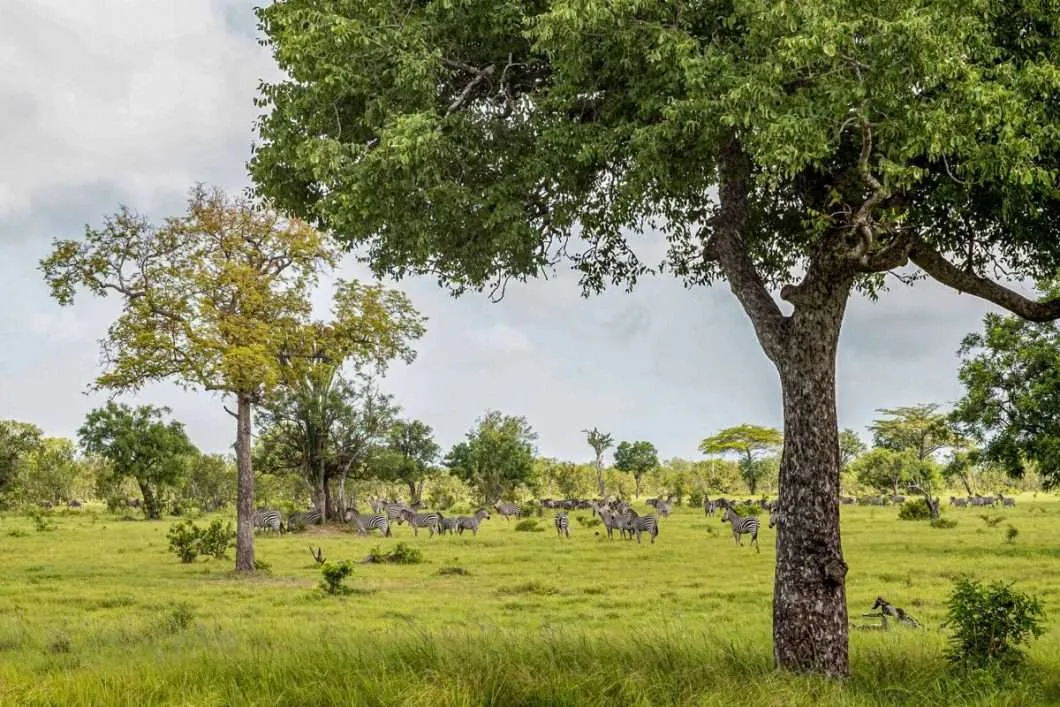
Selous Game Reserve
Selous Game Reserve is the real untamed Africa—not what tourism makes it to be. The reserve is a UNESCO World Heritage Site, one of the few natural wildernesses found in Tanzania. It covers 50,000 square kilometres (19,305 square miles), 5% of Tanzania and is the largest national park in Africa and the second-largest worldwide.

Gombe Stream & Mahale Mountains
If you plan on tracking the intriguing, beguiling, and oh-so-human chimpanzees on your first safari in Tanzania, you must visit the remotest Gomber and Mahale in the extreme west. It takes a great effort and time to get to one or both of these dramatically beautiful remote parks. Because of their remoteness, there are very few visitors, and very few other people on earth will share your experience.
How much is a safari in Tanzania? (USD)
| Shoestring
$ | Budget
$$ | Mid-range
$$$ | High-end
$$$$ | |
|---|---|---|---|---|
| Camps & Lodges | under $250 | $250 – 450 | $451 – $600 | over $600 |
| Restaurants (per meal) | under $12 | $12 – $20 | $21 – $30 | over $30 |
| Safari Vehicle (per day) | under $100 | $100 – $150 | $151 – $250 | over $250 |
| Local Guide (per day) | under $50 | $50 – $150 | $150 – $250 | over $250 |
Most Tanzania safari lodges offer a full-board per person rate, including meals, taxes, and assuming double occupancy. Others offer an all-inclusive room rate to include park fees, transfers, activities, and everything full-board offers. A few lodges operate on a half-board rate, and rare ones offer bed & breakfast except city hotels.
Other places you can visit when you have the time
If you still have time on your first safari after you’ve explored the Must-See parks in Tanzania, put the following national parks on your bucket list, too: Arusha, Ruaha, and Tarangire.
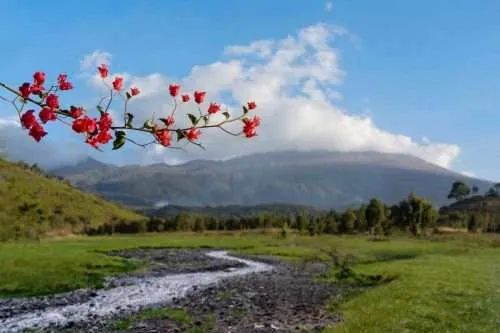
Arusha National Park
Though it covers only 137 square kilometres (58 square miles), Arusha National Park has more to see than many much larger reserves, and it is your gateway to climbing Mount Meru.

Tarangire National Park
Tarangire is an easy 118-kilometre (71-miles) drive from Arusha and adjacent to Lake Manyara. The park is Tanzania’s well-kept secret featuring the wildebeest migration, large elephant herds, baobab trees, and the big five.

Ruaha National Park
East African safari enthusiasts claim Ruaha to be the Tanzania safari’s best-kept secret. The park has huge concentrations of buffalos, elephants, antelope, and more than 400 bird species.
Tanzania’s Gateway Cities
Many visitors to Tanzania will find themselves with a layover in Dar es Salaam or Arusha before or after their safari. Dar es Salaam is often dismissed as a mere transition point, but it’s a city on the rise and a wonderful expression of the changing landscape of modern Tanzania beyond the beach and safaris. For some ideas and suggestions to help determine where you should stay, eat, and, if you have time, sightsee, read on.
Essential information for planning your first safari in Tanzania
Tanzania is generally a safe destination for safari travelers. While violent crime exists, mugging and bag snatching are rare, especially outside of big cities. You’ll always have a private safari driver and guide with you who knows the country and lodge surroundings intimately and can keep you safe.
When it comes to air travel, you’ll often fly in light, mainly propeller-driven aircraft on domestic and safari journeys. While some airlines may not be on the International Air Transport Association’s list of registered airlines that meet safety standards, it doesn’t necessarily mean they’re unsafe. The International Civil Aviation Organization has audited the implementation of critical elements of safety oversight in Tanzania, and you can find a list of incidents and flight accidents in Tanzania on the Aviation Safety Network website.
If you plan to travel to regional countries like Uganda to see the great apes, check your tour operator’s travel advice for each country you intend to visit. Information about backpacking in Tanzania’s remote areas can be patchy, so invest in an up-to-date travel guide and use reliable tour companies like Nkuringo Safaris to plan your private Tanzania Safari.
Self-driving in Tanzania can be challenging, and the quality of car hire companies is variable, so consider using reputable local taxis as an alternative. Driving conditions in Tanzanian’s national parks can be unpredictable, with dirt tracks becoming hazardous or impassable after heavy rain. Use 4×4 cars and avoid driving out of major towns and cities at night. There are frequent police roadblocks, so if the police stop you, ask to see their identification before making any payments for traffic violations.
It’s best to avoid all political demonstrations and rallies, as protests and rallies in Tanzania can turn violent and result in fatalities. Police may use tear gas and live ammunition for crowd control, so stay informed about local news and events before you travel. If you become aware of any nearby protests, leave the area immediately and ask your tour guide for updates or check Twitter and local media for up-to-date information.
You can bring in a litre of spirits or wine and up to 200 cigarettes duty-free. Transporting zebra skin or other animal products requires a CITES (Convention of International Trade in Endangered Species of Wild Fauna and Flora) permit. Although you can buy curios made from animal products in Tanzania, your home country may confiscate them on arrival. Don’t buy shells. It is illegal to export elephant ivory, sea turtle products, and wildlife skins without permits.
There are strict regulations on bringing a drone into Tanzania and Zanzibar and flying it for commercial or recreation purposes. You have to acquire a drone permit and license from the Tanzanian Civil Aviation Authority, without which your drone may be impounded on arrival at the airport.
You can not fly a drone in National Parks (due to concerns over poaching), and if the rangers catch you, it will be a hefty fine.
Malaria is a significant health threat in Tanzania, so it’s crucial to take antimalarials and apply bug spray. Consult your doctor or travel clinic before leaving home for up-to-date antimalarial medication. HIV/AIDS is less risky than in some African countries, but it’s always best to avoid having sex with a stranger. Using strong sunscreen is also essential because Tanzania lies just below the equator, where the sun is at its hottest. Stick to bottled water, and make sure the bottle seal is unbroken. Put your medications in your carry-on and bring copies of your prescriptions.
It’s important to visit a travel clinic about 8 to 10 weeks before you travel to find out which health requirements you need. If you’re visiting Tanzania’s safari parks, there’s a high chance that you’ll be visiting a malarial game reserve. Many travelers take oral prophylactic drugs before, during, or after their Tanzania safari holiday to prevent malaria infections. Your travel doctor can advise you on which drugs to take and when to take them.
If you’re pregnant or traveling with children, take extra precautions or consider a non-malarial region for your safari. Some of the primary vaccine jabs to consider before traveling to Tanzania include yellow fever, polio, tetanus, hepatitis A, typhoid, meningococcus, and rabies. Remember that prevention is always better than cure, so take the necessary precautions to ensure a healthy and enjoyable trip to Tanzania.
Local landline and mobile calls are pretty cheap, but hotels add hefty surcharges to phone calls. The need for public telephones in Kenya has fallen away, given that the majority of people carry a mobile phone, so most have been decommissioned or removed. If you don’t want to use your mobile phone because of expensive international roaming fees, buy a Kenyan pay-as-you-go SIM card (from one of the service-provider stores or street vendors—there’s no shortage of them) and add airtime as you need it. The local providers are Airtel, Safaricom, and Telkom. Coverage is good throughout most of the country but can be patchy in remote places—don’t expect to get a signal at an out-of-the-way safari lodge or camp.
Calling Within Kenya
City codes are (020) for Nairobi, (041) for Mombasa, (040) for Diani Beach, and (012) for Lamu; include the first 0 when you dial within the country. When making a phone call in Kenya, always use the full 10-digit number, including the area code, even if you’re in the same area.
Calling Outside Kenya: When dialing out from Kenya, dial 000 before the international code. So, for example, you would dial 000 (0001) for the United States. Other country codes are 00044 for the U.K and 00027 for South Africa.
Internet
Internet is widely available in Kenya. Free Wi-Fi is available in many public places in Nairobi and Mombasa such as restaurants and coffee shops and at almost all hotels—although again, in remote places you won’t be able to connect. You can top up your own phone with data on a Kenyan pay-as-you-go SIM card.
Tanzania offers a wide range of delicious and diverse cuisine. The food in Tanzania’s safari lodges is plentiful and tasty, and if you head to the coast, you’ll enjoy superb seafood and fish with lots of fresh fruit and vegetables.
Tanzanian cuisine is unique, with a powerful Indian influence permeating many dishes. Along the coast and throughout the Zanzibar archipelago, spicy foods are expected, with coconut being a leading ingredient. Regions of Tanzania’s mainland also have their unique local foods, including wali (rice), ugali (cornbread), chapatti (flat wheat bread), nyama choma (grilled meat), mshikaki (marinated beef), samaki (fish), pilau briyani, and ndizi-nyama (plantains with meat).
Tanzanians commonly eat vegetables such as bamia (okra), mchicha (a kind of spinach), njegere (green peas), maharage (beans), and kisamvu (cassava leaves). They also eat at least 17 different types of bananas served with soups, stews, and chips.
Most places in Tanzania cater to all food tastes and dietary requirements, so you can easily find vegetarian, vegan, and gluten-free options. Whether you’re looking for a taste of local cuisine or familiar dishes, Tanzania has something for everyone to enjoy.
When is the best time for a Tanzania safari?
Tanzania experiences two rainy seasons: the short rains (mvuli) from October through December and the long rains (masika) from late February to early May. However, due to global warming, the rains aren’t as regular or intense as they once were.
As a result, it’s not recommended to go on safari during the rainy seasons as many roads become impassable. For example, the roads in Ngorongoro Crater become extremely muddy and challenging to navigate during heavy showers. It’s essential to consider the weather patterns when planning your trip to Tanzania to ensure that you can enjoy all the activities that you have planned without any weather-related hindrances.
The dry season (high season) in Tanzania runs from January to the end of September is the best time for safari, but prices are generally higher during this time. It’s important to find out when your favorite lodge or destination closes, as some are open only during the dry season.
If you’re planning to visit the East African coast, be prepared for hot and humid weather, particularly during the rainy season. However, the weather is cooler and more pleasant during other times of the year. December is the hottest time in Tanzania, just before the long rains, while high-altitude areas such as Ngorongoro Highlands and Mt. Kilimanjaro can experience freezing temperatures.
International Air Travel
Most travellers arrive in Tanzania via Dar es Salaam airport. There are many direct flights to Dar es Salaam from Europe, the Middle East and Africa but no direct flights from the United States.
KLM has direct flights between Dar es Salaam and Amsterdam’s Schiphol airport, and Emirates runs daily flights from Dubai.
Other airlines with frequent flights to Tanzania include Air Tanzania, the national carrier, Emirates, Kenya Airways, Ethiopian Airlines, Uganda Airlines, Fast Jet, Rwandair, South African Airways, and Swiss Air.
Turkish Airlines also operates flights between Istanbul, Dar es Salaam and Kilimanjaro. Oman Air flies to Dar via Muscat and then on to Zanzibar. Qatar and British Airways connect Dar es Salaam and Zanzibar to Doha. Uganda Airlines and Rwandair have daily connections between Dar, Entebbe and Kigali.
Domestic Flights
Tanzania has a host of small charter companies that run daily flights between Zanzibar, Dar es Salaam, Pemba, Mafia and popular tourism destinations, such as the Serengeti.
Chater companies use different small-sized planes, from Cessna props to slightly larger commuters, to transport travellers domestically across Tanzania. It’s quick, fun, and makes for interesting aerial photography.
If you have a severe fear of small planes, you might want to consider road travel, although distances are far and the roads can be very bumpy.
There are strict luggage regulations: it must be soft-sided and weighs 15 to 20 kg (33 to 44 pounds). Ask your Tanzania safari operator for accurate details before you book. Besides, they usually include the domestic flight with the safari package.
Europe and American citizens require a visa to enter Tanzania; it costs USD 100 for US Citizens and $50 for others and is valid for three months.
Please check with your embassy as some countries are visa-exempt. A multiple entry visa costs $100 for everyone, and you can get a transit visa for $30, valid for 14 days.
You can buy a visa upon arrival, but you’ll need cash and at least two passport pictures. Whenever possible, get your visa ahead of time to avoid long lines and headaches. Tanzania issues electronic visas, but no stamp or label in your passport.
You can now apply for your Zanzibar and Tanzania tourist visa online via the official immigration website at https://eservices.immigration.go.tz/. Fill out the online form, make payment, and submit your application online. The application can take ten days to process. You can track your application online or ask for assistance at info@immigration.go.tz.
Passports must be valid six months after your planned departure date from Tanzania.
You will need a valid yellow fever certificate to enter and exit Tanzania.
If you’re travelling from or to South Africa, new immigration regulations require that all children under the age of 18 carry a passport and an Unabridged Birth Certificate that shows the details of both parents.
Currency
The Tanzanian shilling (Tsh) is Tanzania’s official regulated currency. The currency’s notes include 500, 1,000, 2,000, 5,000, and 10,000. The exchange rate fluctuates between Tsh 2450 and 2,803 to EUR 1 (Tsh 2,240 and 2,340 to USD 1.)
VAT in Tanzania is at 18% and is included in the price of everything except for restaurant and activity bills. Remember to ask for VAT to be included in the price, or your bill could add up unexpectedly.
To avoid administrative hassles, keep all foreign-exchange receipts until you leave the country. You may need them as proof when changing any unspent local currency back into your home currency. Don’t keep any shillings—it is not easily possible to change them outside of Tanzania unless you are travelling onward to other East African countries.
Bargaining for the price of anything at local marketplaces is part of the shopping experience. But remember the local exchange rate and pay appropriately—you don’t want to underpay. Still, you also don’t want to be charged exorbitant “tourist” prices.
Most brand hotels accept US dollars, Pound Starlings, Euros and Tanzanian shillings and take all major credit cards. Be aware that using a credit card often comes with a surcharge of 3%–10%. All low-priced hotels accept Tanzanian shillings.
Banks and ATMs
You will find banks and ATMs in most major cities in Tanzania. You can withdraw cash directly from an ATM in Arusha, Dar es Salaam, Mwanza, Stone Town in Zanzibar, Chake Chake on Pemba island, and Mafia island. Most ATMs accept Visa, Visa Electron, Maestro, and MasterCard.
Most ATMs in Tanzania won’t let you withdraw more than about $300 at a time. The ATM cues are longer at the end of the month when everyone gets paid their salaries. The best place to withdraw cash in Tanzania is at an indoor ATM, preferably one guarded by a security officer.
Tipping on Safari in Tanzania
Everyone who serves you at the lodge deserves your appreciation through a tip. Please tip generously in small bills of about 5-10 (€/£/$) per day for the room steward and waiter.
A good safari guide should get a tip of 15-25 (€/£/$) per day per person; if they’ve gone out of their way for you, you may wish to give him more.
It’s a good idea to carry many small-denomination bills. US dollars and British pounds are accepted almost everywhere. But if you’re planning to visit the more remote places in Tanzania, then shillings are preferred.
A Tanzania safari holiday package promises ultimate luxury at many safari camps, lodges, coastal resorts, and hotels. Many travellers highly recommend private camps and lodges for their ultimate luxury. A room usually includes everything from lodging, meals, and beverages (excellent house wines) to transfers, game drives, and other activities.
Check with your safari planning manager whether they include park fees in your rate as they make the cost very high if you have to pay them daily.
The southern Tanzania safari circuit is cheaper in general. Still, you’ll need to factor in the transport cost, which can be pretty pricey.
Many lodges and hotels offer low-season rates, which attracts budget travellers. But remember there are other inconveniences involved in travelling during the low season, like heavy rains and bad roads.
Find out whether the private lodge you’re booking accepts children. Many don’t want to admit kids below 12 years because they don’t have child-friendly facilities.
If your Tanzania trip involves travelling to the more remote parks, allow for more time. Stay at least two nights at each safari camp and experience more than just the animals but landscapes, people and cultures too.
Most lodges offer a laundry service for everything except underwear (it’s against African culture). Remember to pack plenty of underwear pairs, or make sure you bring quick-dry ones so you can wash them as you go.
National park accommodations are few and very basic. Unless you’re a hard-core camper, stick with another type of accommodation.
Lodges are usually one story—and because of the remote locations, safari accommodations are not wheelchair-friendly.
Explore the magic of travelling in Tanzania, Zanzibar and the neighbouring countries with a trusted travel agent!
Tanzania’s Gateway Cities
Although the travel reviews go into great detail about the must-see parks in Kenya, there are many other attractions to explore if you have time. Here are a few good ones our travelers typically choose to add on their first Africa safari in Kenya.

Dar es Salaam
Second, only to Kenya’s Mombasa, Dar es Salaam is East Africa’s busiest port. The name, in Arabic, means “haven of peace”. Dar es Salaam blossoms with exciting restaurants, beautiful hotels, and some of the best nightlife on the coast. It is the gateway to the southern safari circuit, and you can spend your last night here and check out the coastal city before exiting Tanzania.

Arusha
Arusha is the gateway to the northern Tanzania safari circuit, typically the Serengeti Safari. On a clear day in Arusha, you can see Mt. Meru, Africa’s fifth highest mountain at 4,556 meters (14,947 feet), looming in the distance. Some superb accommodation options on the outskirts of Arusha are well worth a day or two pre or post-safari. You can spend a night here to recharge, relax, and be pampered while experiencing Northern Tanzanian hospitality.
Accommodation options for your safari
Uganda offers various holiday accommodation options for safari travelers. Luxury lodges provide private rooms, fine dining, and exceptional service, while budget-friendly campsites offer a more rustic experience with basic amenities and a closer connection to nature. When selecting accommodation, consider its location and proximity to national parks and wildlife reserves, as well as the level of luxury and your budget. Some lodges offer all-inclusive packages, while others charge separately for each service. Take a look at our carefully curated list of lodges and camps that are perfect for wildlife safaris in Uganda.
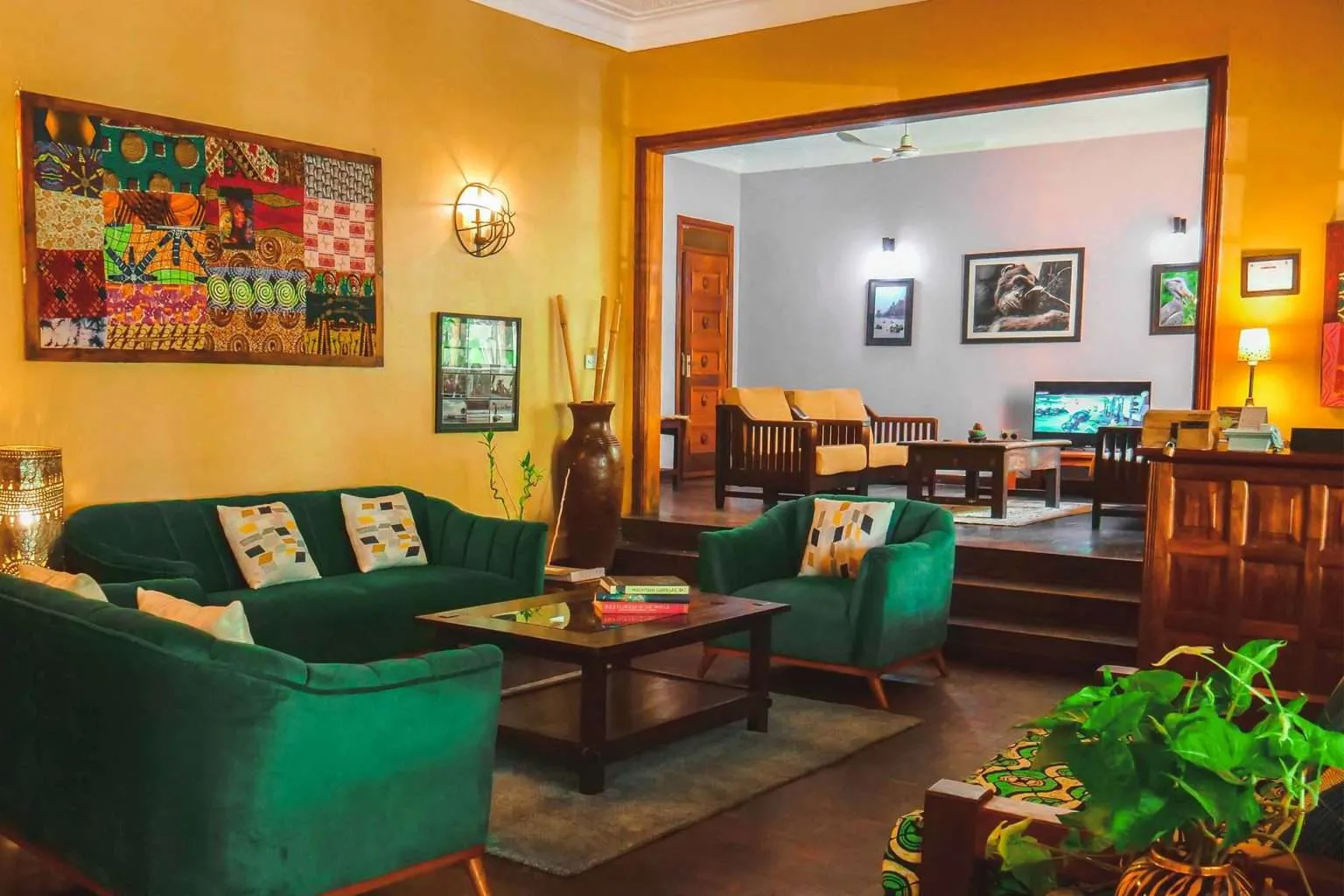
Papyrus Guesthouse Entebbe
From $85 pp
Papyrus Guesthouse is an eco and cozy lodge in the suburbs of Entebbe, about 15 minutes from Entebbe International Airport. It is an excellent choice for safari travelers who hope to relax in Entebbe after/before their international flight.

Number 5 Boutique Hotel
From $190 pp
The Luxury Hotel Number 5 is a quaint suburban boutique retreat nestled in the quiet colonial part of Entebbe. It’s about 15 minutes drive from Entebbe International Airport, the primary entry point to Uganda.

Nkuringo Bwindi Gorilla Lodge
From $300 pp
Nkuringo Bwindi Gorilla Lodge is thoughtfully comfortable and concentrates on cheerful African hospitality, which complements its superb location and function as the best base for gorilla trekking safaris in the south of Bwindi Impenetrable National Park.
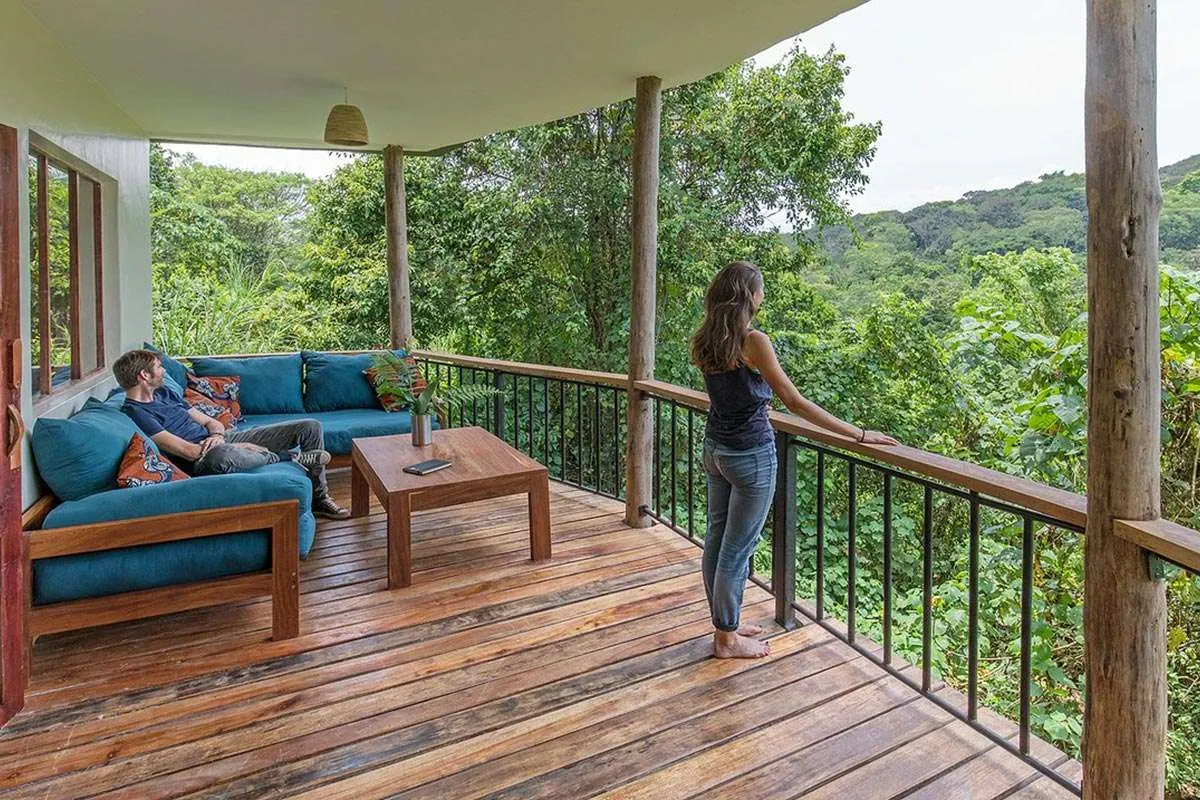
Turaco Treetops Lodge
From $95 pp
Turaco Treetops is a lush semi-luxury lodge on the edge of Kibale National Park. It’s got stunning views of the forest canopy, the massive Rwenzori mountains, and the creator lake decorated landscape of the region.
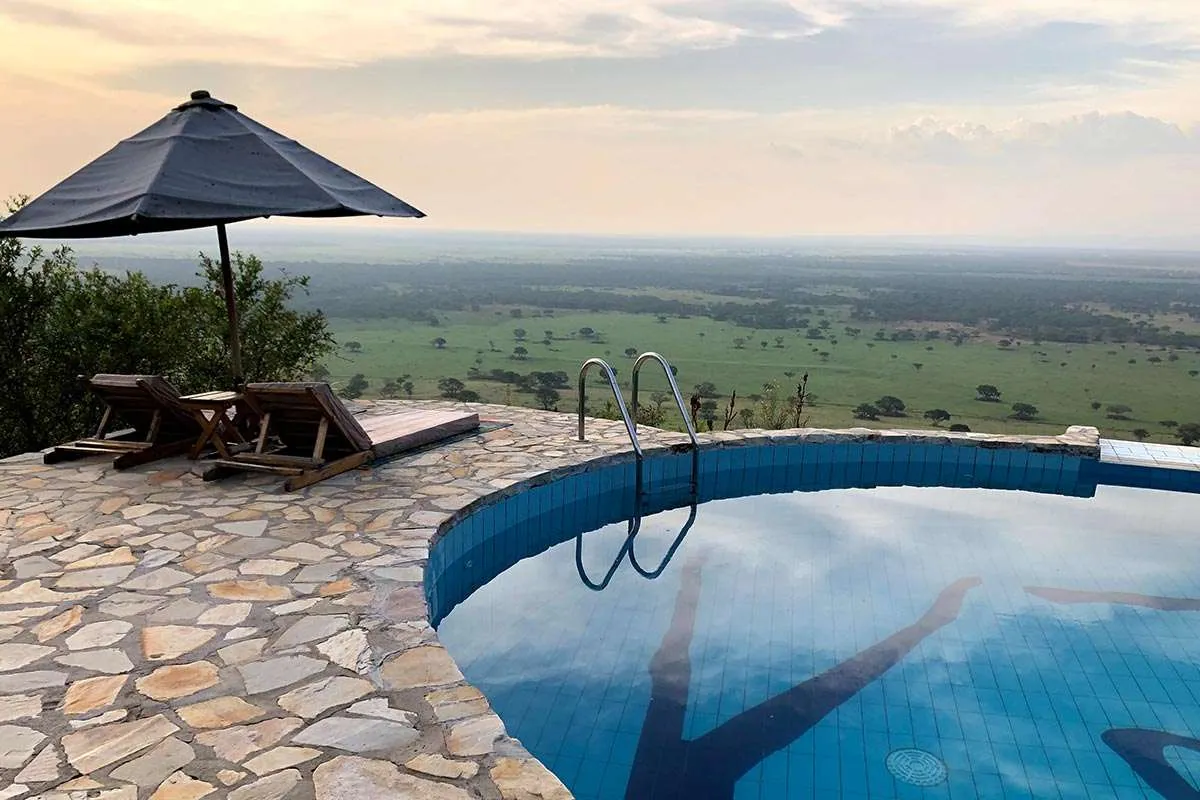
Katara Lodge
From $200 pp
Katara Lodge sits on escarpment farmland overlooking Queen Elizabeth National Park’s northeastern sector in western Uganda, A pleasant intimate, and simple safari lodge with eight cottages overlooking the vast park’s savannah plains.

Katara Lodge
From $200 pp
Katara Lodge sits on escarpment farmland overlooking Queen Elizabeth National Park’s northeastern sector in western Uganda, A pleasant intimate, and simple safari lodge with eight cottages overlooking the vast park’s savannah plains.
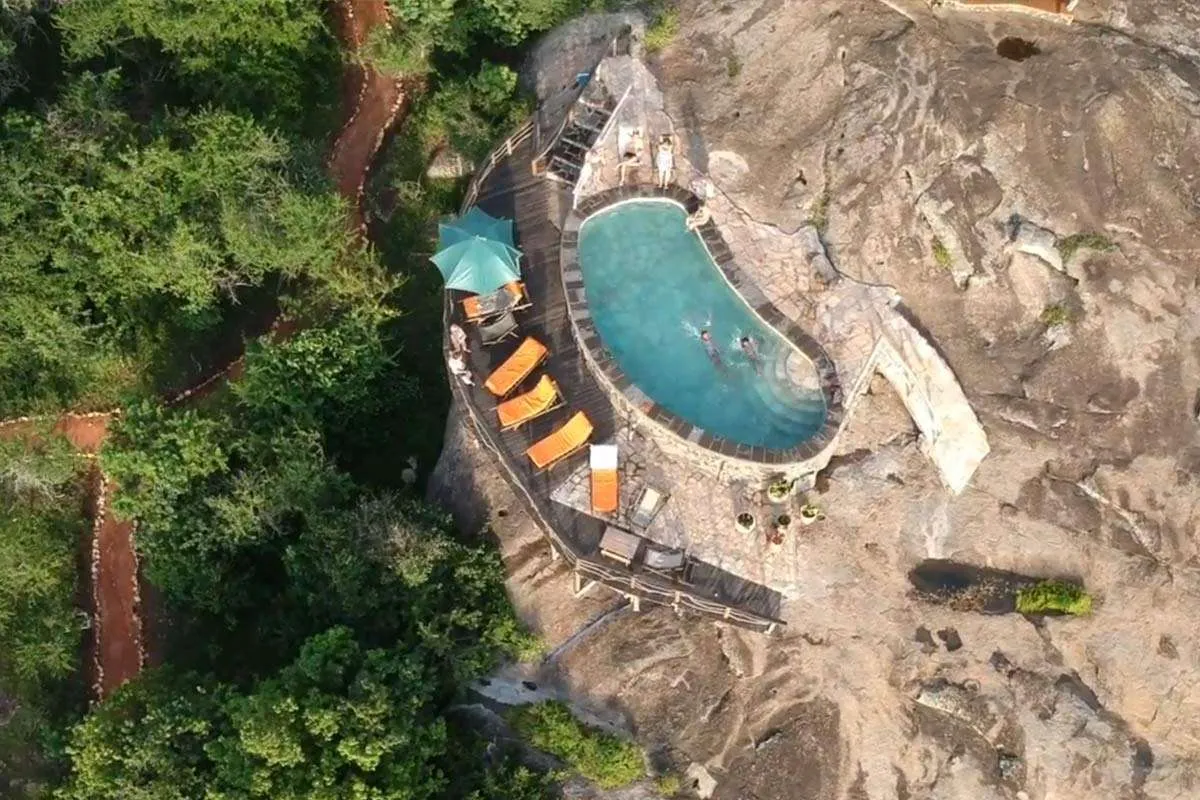
Rwakobo Rock Lodge
From $155 pp
Rwakobo Rock Lodge is a wilderness retreat secluded on a rocky outcrop at the edge of Lake Mburo National Park’s northern border. The lodge provides private getaways in the locally-styled cottages dotted around a massive granite outcrop, with stunning views over the wilderness plains.

Apoka Safari Lodge

Mount Gahinga Lodge
From $880 pp
Nestled in the foothills of the Virunga Volcanoes, Mount Gahinga Lodge is an exclusive vacation lodge with a tranquil charm enthralled by the dramatic backdrop of three of the extinct Virunga volcanoes. Its rustic charm creates an absorbing atmosphere of tranquility and the region’s history.






